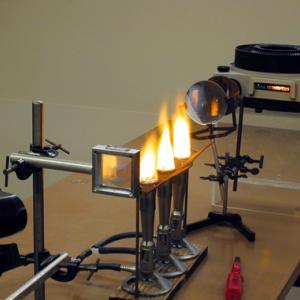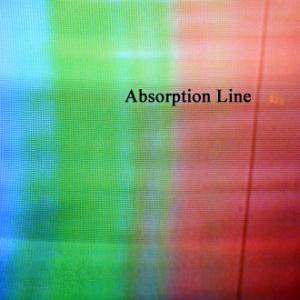College of Liberal Arts & Sciences
7B11.15 - Spectral Lines/Spectroscopy - Sodium Absorption
See also 7B11.15 in Astronomy.
Video Credit: Jonathan M. Sullivan-Wood.
The sodium absorption stuff is set up as shown. Observe the distances fairly carefully as it is a critical part of making this work. The lens of the slide projector will need to be turned almost clear out. Light the burners and wait until they burn with a bright yellow flame before putting into the light path. Focus the camera onto the red-yellow end of the spectrum showing on the grating.
Note: The burners must be lined up in the light path.
The white light spectrum observed will have many streaks in it due to light bulb configurations. To minimize this the use of a diffusing screen is advised. The one that we are using is in a 35 mm slide holder and can be inserted directly into the slide projector.
- Colin S. Wallace, Edward E. Prather, Seth D. Hornstein, Jack O. Burns, Wayne M. Schlingman, and Timothy G. Chambers, "A New Lecture-Tutorial for Teaching about Molecular Excitations and Synchrotron Radiation", TPT, Vol. 54, #1, Jan. 2016, p. 40.
- Michael Gore, "Shedding Light on Darkness", TPT, Vol. 45, #4, Apr. 2007, p. 250.
- Paul Hewitt, "Figuring Physics: Absorption Spectra", TPT, Vol. 43, #2, Feb. 2005, p. 74.
- Bruce C. Palmquist, "Interactive Spectra Demonstration", TPT, Vol. 40, #3, Mar. 2002, p. 140.
- Donald F. Collins, "Video Spectroscopy - Emission, Absorption, and Flash", TPT, Vol. 38, #9, Dec. 2000, p. 561.
- Kenneth Brecher, "Do Atoms Really 'Emit' Absorption Lines?", TPT, Vol. 29, #7, Oct. 1991, p. 454.
- Haym Kruglak, "Apparatus for Displaying Three Types of Spectra", TPT, Vol. 23, #5, May 1985, p. 314.
- Zenon Gubanski, "Demonstrating the Line Absorption Spectrum of Sodium Vapor", TPT, Vol. 18, #2, Feb. 1980, p. 140.
- "Did Cave Men Ever See a Fraunhofer Spectrum", TPT, Vol. 15, #2, Feb. 1977, p. 93.
- Mary Jane Gary and Victor G. Mossotti, "Nonflame Absorption Spectroscopy: A Technique for Elemental Analysis", TPT, Vol. 13, #6, Sept. 1975, p. 362.
- Edwin Paul Heideman, "Absorption Spectra", TPT, Vol. 9, #6, Sept. 1971, p. 345.
- Robert de Levie, "On Deconvolving Spectra", AJP, Vol. 72, #7, July 2004, p. 910.
- Noojin Walker, Jr., "A Spectroscopic Sodium Flame", AJP, Vol. 31, #12, Dec. 1963, p. 945.
- Wallace A. Hilton, "S-5", Experiments in Optical Physics, p. 55 - 56.
- Wallace A. Hilton, "S-4", Experiments in Optical Physics, p. 53.
- George M. Hopkins, "Light", Experimental Science, p. 214 - 215.
- Isaac Asimov, "What Are Little Stars Made Of?", Fantasy and Science Fiction Magazine, p. 125 - 134.
- W. Bolton, "Sodium Impurity", Book 2 - Waves and Particles, Physics Experiments and Projects, 1968, p. 81 - 82.
- W. Bolton, "Beer's Law", Book 2 - Waves and Particles, Physics Experiments and Projects, 1968, p. 47 - 48.
- Joseph Frick, "#7 - Frauenhofer's Lines", Physical Technics: Or, Practical Instructions for Making Experiments in Physics and the Construction of Physical Apparatus with the Most Limited Means", p. 196.
Disclaimer: These demonstrations are provided only for illustrative use by persons affiliated with The University of Iowa and only under the direction of a trained instructor or physicist. The University of Iowa is not responsible for demonstrations performed by those using their own equipment or who choose to use this reference material for their own purpose. The demonstrations included here are within the public domain and can be found in materials contained in libraries, bookstores, and through electronic sources. Performing all or any portion of any of these demonstrations, with or without revisions not depicted here entails inherent risks. These risks include, without limitation, bodily injury (and possibly death), including risks to health that may be temporary or permanent and that may exacerbate a pre-existing medical condition; and property loss or damage. Anyone performing any part of these demonstrations, even with revisions, knowingly and voluntarily assumes all risks associated with them.


